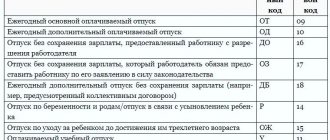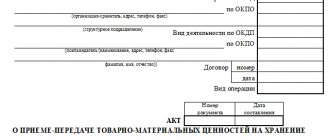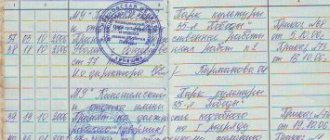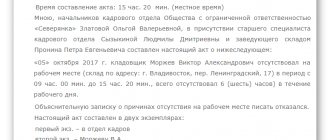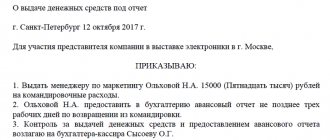Document year: 2019
Document group: Acts
Type of document: Act
Download formats: DOC, PDF
The act of hidden work confirms the quality of intermediate but important work, certifies compliance with standards and GOSTs, technical and design documentation.
During construction, reconstruction and major repairs, there are a number of works that cannot be visually inspected and assessed. Such work includes, for example, sound insulation, rough work on finishing walls, ceilings and floors, laying pipes, fastenings in walls. Their quality and compliance with design estimates and standards is assessed at the intermediate stages of construction and repair. Documentary evidence of the inspection of hidden work is a signed act. Without it, further construction, repair or reconstruction is prohibited.
The sample from Appendix No. 3 of the Rostechnadzor Order is used as a template for the act. It will be available for free at the end of the article. Let's consider the rules of compilation and instructions for registration.
Rules for drawing up a hidden work report
The act of hidden work is the last stage in assessing their quality and compliance with all norms and standards. The paper certifies that this stage of construction or repair has been completed efficiently, so you can move on to the next stage.
The inspection of hidden work is carried out by an authorized commission, which draws up and signs the report. Important points in preparing the paper:
| the need to indicate the details of the parties involved (customer, company carrying out construction, design office) |
| assigning a number and date of preparation to the act |
| information about representatives of each party |
| presentation of detailed information about hidden work (name, compliance with design documentation, what materials were used during construction) |
| the start and end dates of the work are indicated, the quantity in which the act is drawn up, what documents are attached to it, what notes there are |
The act is signed by all authorized persons (surname, initials and signature). Drawings, sketches and photographs are attached to the paper.
Important! The finished object will not be accepted if there are no certificates of inspection of hidden work, or the papers are drawn up with errors.
The contractor will be required to evaluate the work performed, and when the object is finished, it will be necessary to open the walls, ceilings and floors in order to assess the quality of the work. These are the contractor's losses. Therefore, it is important to conduct a timely inspection of hidden work and draw up a report correctly.
Certificate of inspection of hidden works - sample completion 2020.
So, what does the act of carrying out hidden work look like ? Below we provide a sample of filling out an inspection report for hidden work on installing sound insulation in the floors of an apartment. We will talk about the order itself and the rules for filling it out later.
Sample of filling out an act for hidden soundproofing work.
Certificate of inspection of hidden works - sample completion 2016.
As can be seen from the presented report, the sound insulation is made in the form of Schumanet 8 mm thick. The certificate was certified by the designers (representatives of architectural supervision) who carried out the redevelopment project, and by the builders (contractor) who carried out the repair itself.
A hidden work report is a sample for a frame to reinforce an opening in a load-bearing wall.
The act of acceptance of hidden work is a sample.
The reinforcement frame is made of metal corners and plates, after which it is welded with reinforcement and mesh for subsequent plastering. The completed act for hidden work is also certified by the designers and builders.
Certificate of hidden waterproofing work - sample.
Certificate for hidden floor waterproofing work.
The picture shows another example of filling out a hidden work inspection report. This time it is designed for coating waterproofing in bathrooms. Sometimes roll waterproofing (for example, hydroglass insulation) is also used for waterproofing bathrooms, but they require a leveling layer of screed before installation. Otherwise, the waterproofing under the load from the upper layers of the floor and screed may tear due to the unevenness of the floor slab and, thus, deteriorate.
https://youtu.be/yi5X62yVGYc
Instructions for drawing up a hidden work report
Acceptance certificates for hidden work are drawn up in printed or written form in A4 format. From the point of view of office work, there is nothing complicated in the registration; the main thing is to fill out all the necessary lines without errors and typos, and sign the paper with each representative.
Sample of filling out a hidden work report:
- Indication of the capital construction project (exact address, name of design and estimate documentation (DED), construction address).
- Filling out information about the developer, project developer and construction company. These can be either individual entrepreneurs or legal entities. The columns indicate the names, addresses, OGRN and taxpayer number for legal entities. If the participant is an individual entrepreneur, then the fields must be filled in with the full name, tax identification number and address of residence.
- The act number and date of preparation are indicated (month in words).
- Information is provided about representatives of the developer, a representative from the contractor, a person exercising control, a developer of project documentation responsible for performing hidden work, as well as other persons participating in the survey.
- The main part describes the hidden work, according to which design documentation it was carried out, what building materials were used, what documents certify compliance with the requirements.
- The fifth paragraph indicates the start and end dates of work.
- Filling out documentation in accordance with which hidden work was performed.
- Permission is given to carry out subsequent work. If representatives have comments, they are listed in the paragraph below.
- The number of copies and the list of applications are indicated.
At the end, signatures with the initials of the representatives are placed. To the question whether a seal is needed on the act, the answer is: if the organization has one, it is better to put one.
What is regulated
The phrase “construction and installation work” refers to a set of technological processes. The quality of their production is verified through independent examination by the relevant authorities in the field of construction of buildings and structures.
The results of the inspection are documented in the executive documentation provided for by SNiP, GOST, which includes an act of hidden work. It ensures the protection of the interests of the customer of the facility.
The issue of its preparation is regulated by a number of legislative and by-laws:
| Indicators | Description |
| Town Planning Code of the Russian Federation | The act was published on December 29, 2004 under number 190-FZ |
| Order of Rostechnadzor “On approval and implementation of the Requirements for the composition and procedure for maintaining as-built documentation during construction, reconstruction, major repairs of capital construction projects and the requirements for inspection reports of works, structures, sections of engineering support networks” | The act was issued on December 26, 2006 under number 1128. Its last revision dates back to November 9, 2020 |
| Building codes and regulations 01/3/87. | “Acceptance into operation of completed construction projects. Basic provisions". The act came into force on January 1, 1988 |
List of works subject to inspection by acts of hidden work
A sample list contains:
- various types of excavation work (excavation of pits, backfilling of excavations, drilling of wells);
- hydro-, steam-, heat- and sound insulation;
- installation and coating of a protective layer against corrosion of metal structures;
- installation of window and door units;
- installation of foundations for floors;
- anti-corrosion protection of welding joints;
- installation of reinforced concrete foundation;
- and many other procedures.
The exact list of hidden works is established in the project documentation of the facility.
Order of Rostekhnadzor dated December 26, 2006 No. 1128
The order establishes a list and procedure for drawing up executive documentation for construction, reconstruction of existing buildings and major repairs. The Appendices to the Order provide sample acts. The third appendix contains a recommendatory sample act for the inspection of hidden work. The Order itself defines:
- a complete package of as-built documentation is drawn up by the performer (contractor). This includes text documents, drawings and other graphic designs;
- documentation is drawn up in writing. By agreement - electronically;
- if electronic document management is used, it is supported by an enhanced digital signature.
The list of hidden works that need to be certified by an act is compiled in the project documentation.
The sixth paragraph establishes the full composition of the executive documentation, except for the established appendices 1-5.
Order of Rostechnadzor dated October 26, 2020 No. 428
The 2020 Order made some changes to the 2006 Order, the last changes were made on November 9, 2020, by Order No. 470.
Editorial changes related specifically to the examination of hidden work affected only the wording of the text.
Eg! As amended in 2006, it is written in paragraph 5.3 “Acts of inspection of works that have an impact.” The 2017 edition simply states “Inspection of works that have an impact.” This did not affect changes in the act form.
What is hidden work
When the construction is completely completed, there is no way to see such work with your own eyes, or to check the correctness of its implementation. Of course, the structure can be dismantled to ensure that the work is done correctly. But it is much easier to carry out this check in advance. After the inspection, specialists draw up a document, which becomes an official confirmation of the correctness of the work.
( Video : “Act of inspection of hidden reinforcement work”)
The list of hidden works is quite large. This includes anything that cannot be inspected after the final completion of construction. After drawing up the act, it is signed by all members of the commission. Such an act is considered completed and gives permission to continue construction and repair work. In addition, the document indicates that the part of the structure covering the hidden work is strong enough and allows construction to continue. The act allows the customer to verify that the material from which hidden work is performed meets the data specified in the estimate.
What is regulated
Regulatory document RD-11-02-2006 determines the procedure for maintaining documents that are drawn up during construction.
It says here that the act is mandatory for reconstruction, capital construction, and repairs. The contractor has the right to continue construction only after confirming the correctness of the hidden work. In 2020, some changes were made to the document regarding the filling out form. It should be understood that these rules are necessary in order to ensure maximum safety of structures, structures, buildings and other objects during their operation. That is why the inspection of intermediate work must be treated with the utmost responsibility. It is also prohibited by law to use facilities that do not have this act after completion of construction.
It must be remembered that if such work has not been properly certified, the customer, as well as the inspection authorities, will demand that the structure be completely or partially dismantled. If violations are detected, the contractor is required to correct them. Naturally, dismantling and re-erection is carried out at the expense of the guilty party, namely the contractor.
IGASN form No. 11/94
F. IGASN No. 11/94 was used to examine hidden work for objects located in the city of Moscow. The sample act was established by Order of the Moscow Government back in 1999.
If we compare IGASN 11/94 with the form of the Appendix of the Order of Rostechnadzor, we can draw the following conclusions:
- example f. IGASN simplified;
- the same basic information is written down;
- The number of copies and information about applications is not indicated.
Important! The form was repealed when the 1999 Order was repealed. The template is not currently in use.

